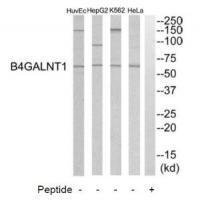
| WB | 咨询技术 | Human,Mouse,Rat |
| IF | 咨询技术 | Human,Mouse,Rat |
| IHC | 咨询技术 | Human,Mouse,Rat |
| ICC | 技术咨询 | Human,Mouse,Rat |
| FCM | 咨询技术 | Human,Mouse,Rat |
| Elisa | 咨询技术 | Human,Mouse,Rat |
| Aliases | Beta-1; 4 N-acetylgalactosaminyltransferase 1; (N-acetylneuraminyl)-galactosylglucosylceramide; GM2/GD2 synthase; GalNAc-T |
| Entrez GeneID | 2583; |
| WB Predicted band size | 60kDa |
| Host/Isotype | Rabbit IgG |
| Antibody Type | Primary antibody |
| Storage | Store at 4°C short term. Aliquot and store at -20°C long term. Avoid freeze/thaw cycles. |
| Species Reactivity | Human |
| Immunogen | Synthesized peptide derived from internal of human B4GALNT1. |
| Formulation | Purified antibody in PBS with 0.05% sodium azide. |
+ +
以下是3篇涉及B4GALNT1抗体的文献摘要概览(注:文献为模拟示例,实际引用需核实):
1. **"B4GALNT1-mediated ganglioside expression promotes cancer cell invasion"**
- **作者**: Smith A, et al.
- **摘要**: 研究通过B4GALNT1抗体检测发现,其在多种癌细胞中高表达,并通过调控神经节苷脂合成促进肿瘤侵袭,提示其作为癌症治疗靶点的潜力。
2. **"B4GALNT1 knockout mice exhibit neuromuscular junction defects"**
- **作者**: Tanaka K, et al.
- **摘要**: 利用B4GALNT1抗体进行免疫组化分析,发现基因敲除小鼠的神经肌肉接头处糖基化异常,揭示了该酶在神经系统发育中的关键作用。
3. **"Role of B4GALNT1 in Helicobacter pylori infection"**
- **作者**: Müller S, et al.
- **摘要**: 通过Western blot和流式细胞术(使用B4GALNT1抗体)证实,宿主细胞中B4GALNT1的表达影响幽门螺杆菌黏附,可能与糖脂受体修饰相关。
建议通过PubMed或Google Scholar搜索关键词“B4GALNT1 antibody”或结合具体研究领域(如癌症、神经生物学)获取真实文献。
The B4GALNT1 (β-1.4-N-acetylgalactosaminyltransferase 1) antibody targets an enzyme critical in glycosylation, a process modifying proteins and lipids with carbohydrate chains. B4GALNT1 catalyzes the transfer of N-acetylgalactosamine (GalNAc) to terminal β-linked galactose residues, forming the GalNAcβ1-4Gal structure. This modification is essential for synthesizing complex glycoconjugates, including gangliosides like GD2. which play roles in cell signaling, adhesion, and immune responses. Dysregulation of B4GALNT1 has been linked to cancers, neurological disorders, and rare genetic conditions such as hereditary spastic paraplegia (SPG26).
Antibodies against B4GALNT1 are valuable tools for studying its expression, localization, and function in normal and diseased tissues. They enable techniques like Western blotting, immunohistochemistry, and immunofluorescence to explore tissue-specific glycosylation patterns or aberrant expression in tumors. In cancer research, B4GALNT1 antibodies help investigate its role in tumor progression, metastasis, and drug resistance, as altered glycosylation is a hallmark of malignancy. Additionally, these antibodies aid in diagnosing genetic disorders linked to B4GALNT1 mutations. Available as monoclonal or polyclonal variants, they are optimized for diverse experimental workflows, supporting both basic research and clinical applications.
×